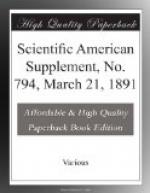Many experiments have been made with the view of determining the percentage of carbon monoxide in air which is fatal to human or, rather, animal life, and the most reliable as well as the latest results are those obtained by Dr. Stevenson, of Guy’s Hospital, in consequence of the two deaths which took place at the Leeds forge from inhaling uncarbureted water gas containing 40 per cent. of carbon monoxide. He found that one per cent. visibly affected a mouse in one and a half minutes, and in one hour and three quarters killed it, while one-tenth of a per cent. was highly injurious. Let us, for the sake of argument, take this last figure 0.1 per cent. as being a fatal quantity, so as to be well within the mark.
In ordinary carbureted water gas as supplied by the superheater processes, such as the Lowe, Springer, etc., the usual percentage of carbon monoxide is 26 per cent., but in the Van Steenbergh gas—for certain chemical reasons to be discussed later on—it is generally about 18 per cent., and rarely rises to 20 per cent. An ordinary bedroom will be say 12 ft. X 15 ft. X 10 ft., and will therefore contain 1,800 cubic feet of air, and such a room would be lighted by a single bats-wing burner consuming not more than four cubic feet of gas per hour. Suppose now the inmate of that room retires to bed in such a condition of mental aberration that he prefers to blow out the gas rather than take the ordinary course of turning it off—a process, by the way, of putting out gas which is decidedly easier in theory than in practice, especially in his presumed mental condition—you would have in one hour the 1,800 cubic feet of gas in the room mixed with four fifths of a cubic foot of carbon monoxide—the carbureted water gas being supposed to contain 20 per cent.—or 0.04 per cent. In such a room, however, if the doors and windows were absolutely air tight, and there was no fireplace, diffusion through the walls would change the entire air once an hour, so that the percentage would not rise above 0.04; while in any ordinary room imperfect workmanship and an open chimney would change it four times in the hour, reducing the percentage to 0.01, a quantity which the most inveterate enemy of water gas could not claim would do more than produce a bad headache, an ailment quite as likely to have been caused by the same factor that brought about the blowing out of the gas.
Moreover, we are now talking about the use of carbureted water gas as an enricher of coal gas, and not as an illuminant to be consumed per se. and we may calculate that it would be probably used to enrich a 16-candle coal gas up to 17.5 candle power. To do this 25 per cent. of 22 candle power carbureted water gas would have to be mixed with it, and taking the percentage of carbon monoxide in London gas at 5 per cent.—a very fair average figure—and 18 per cent. as the amount present in the Van Steenbergh gas, we have 8.25 per cent. of carbon monoxide in the gas as sent out—a percentage hardly exceeding that which is found in the rich cannel gas supplied to such towns as Glasgow, where I am not aware of an unusual number of deaths occurring from carbon monoxide poisoning.




